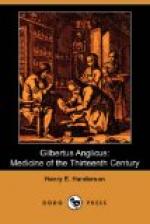“Ut tamen secundum ordinem procedamus, in primis cognosactur cognoscere desiderantibus, ne dolus dolo patrocinetur, vel simplex dolose muscipula claudatur.”
[Footnote 6: This apparent anachronism carries us back to the history of the mythical Island of Brazil, which appeared upon our charts as late as the middle of the 19th century.]
In the department of neurology Gilbert, after a philosophical discussion of the nature and variety of pain, devotes considerable chapters to the causes, symptoms, diagnosis and treatment of headache, hemicrania, epilepsy, catalepsy, analepsy, cerebral congestion, apoplexy and paralysis, phrenitis, mania and melancholia, incubus or nightmare, lethargy and stupor, lippothomia or syncope, sciatica, spasm, tremor, tetanus, vertigo, wakefulness, and jectigation (jactitation, formication, twitching).
The third book of the Compendium opens with several chapters on the anatomy and physiology of the eye and the phenomena of vision. According to Gilbert, the eye consists of three humors, the albugineous (aqueous), the crystalline lens and the vitreous humor, and seven tunics, apparently
1. The conjunctiva 2. The albuginea or sclerotic 3. The cornea 4. The secundina (choroid) 5. The rethilea (retina) 6. The aranea (iris) 7. The uvea perforata (posterior layer of iris),
though the definitions are not in all cases quite clear and definite. The tela aranea is said to take its origin from the retina, the retina from the optic nerve, and the latter from the rethi (rete, network) involving the substance of the brain. The cornea arises from the sclerotic tunic, the uvea and secundina take their origin from the pia mater, and the conjunctiva from a thin pellicle or membrane which covers the exterior of the cranium and is nourished by a transudation of the blood through the coronal suture. This pellicle is also said to have a connection with the heart, which arrangement furnishes a decidedly curious explanation of the mechanism of sympathetic and maudlin lachrymation. For, as Gilbert tells us, when the heart is compressed this pellicle is also compressed, and if any moisture is found beneath the pellicle it is expressed into the substance of the lachrymal gland by the constriction of the heart, and men in sorrow therefore shed tears. And again, if the heart is much dilated or elevated (by joy), this pellicle is also dilated or elevated, and if any moisture is found beneath it, it is expressed in the form of tears. Accordingly, men who are too joyful shed tears. Still further, drunken men, who are notoriously “moist,” and have a superfluity of fluid between the pellicle and the skin of the cranium, are prone to weeping on slight provocation, and their tears are nothing more than an expression of this moisture, which makes its exit, not through the substance of the eye, but through the “lachrymal angle.” Q.E.D.




